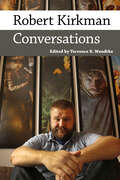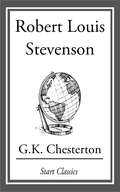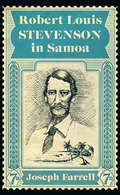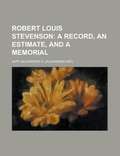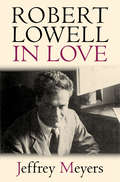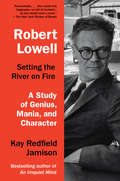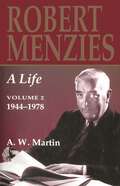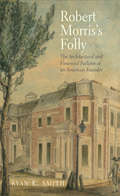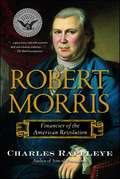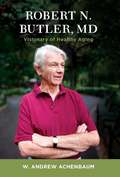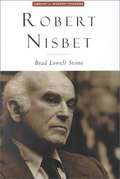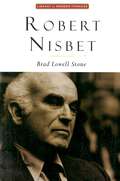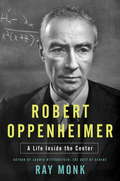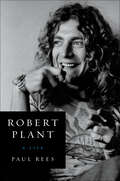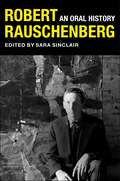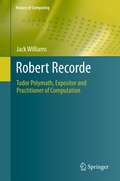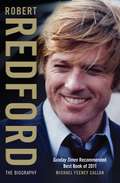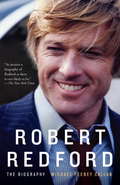- Table View
- List View
Robert Kennedy and His Times
by Arthur M. Schlesinger Jr.The Pulitzer Prize–winning historian chronicles the short life of the Kennedy family&’s second presidential hopeful.Schlesinger&’s account vividly recalls the forces that shaped Robert Kennedy, from his position as the third son of a powerful Irish Catholic political clan to his concern for issues of social justice in the turbulent 1960s. Robert Kennedy and His Times is &“a picture of a deeply compassionate man hiding his vulnerability, drawn to the underdogs and the unfortunates in society by his life experiences and sufferings&” (Los Angeles Times). This fortieth anniversary edition contains not only Schlesinger&’s illuminating and inspiring portrait of Robert Kennedy, but a new introduction by Michael Beschloss, in which the acclaimed bestselling author and historian discusses the book&’s initial reception, Schlesinger&’s thoughts on it, and expounds on why Robert Kennedy is still such an important figure today.&“Exceptionally important, one of a handful of books that anyone who cares for the politics of the &’60s must read.&” —Newsweek&“An absorbing and vividly written study of a gallant and tragic man.&” —The Boston Globe &“A story that leaves the reader aching for what cannot be recaptured.&” —Miami Herald &“An inspiring account of what it was like to be at Robert Kennedy&’s side and why he and many like him felt that vision and virtue walked with them.&”—Business Week
Robert Kirkman: Conversations (Conversations with Comic Artists Series)
by Terrence R. WandtkeRobert Kirkman (b. 1978) is probably best known as the creator of The Walking Dead. The comic book and its television adaptation have reinvented the zombie horror story, transforming it from cult curiosity and parody to mainstream popularity and critical acclaim. In some ways, this would be enough to justify this career-spanning collection of interviews. Yet Kirkman represents much more than this single comic book title.Kirkman’s story is a fanboy’s dream that begins with him financing his irreverent, independent comic book Battle Pope with credit cards. After writing major titles with Marvel comics (Spider-Man, Captain America, and X-Men), Kirkman rejected companies like DC and Marvel and publicly advocated for creator ownership as the future of the comics industry. As a partner at Image, Kirkman wrote not only The Walking Dead but also Invincible, a radical reinvention of the superhero genre. Robert Kirkman: Conversations gives insight to his journey and explores technique, creativity, collaboration, and the business of comics as a multimedia phenomenon. For instance, while continuing to write genre-based comics in titles like Outcast and Oblivion Song, Kirkman explains his writerly bias for complex characters over traditional plot development. As a fan-turned-creator, Kirkman reveals a creator’s complex relationship with fans in a comic-con era that breaks down the consumer/producer dichotomy. And after rejecting company-ownership practices, Kirkman articulates a vision of the creator-ownership model and his goal of organic creativity at Skybound, his multimedia company. While Stan Lee was the most prominent comic book everyman of the previous era of comics production, Kirkman is the most prominent comic book everyman of this dynamic, evolving new era.
Robert Louis Stevenson
by G. K. Chesterton1928. G.K. Chesterton was a journalist, poet, novelist, playwright, debater, and Catholic apologist in the early twentieth century. When Stevenson first appeared, Sir Edmund Gosse, England's leading literary critic, wrote: I have just finished reading the book in which you smite the detractors of R.L.S. hip and thigh. I cannot express without a sort of hyperbole, the sentiments which you have awakened; of joy, of satisfaction, of relief, of malicious and vindictive pleasure. We are avenged at last...It is and always since his death has been impossible for me to write anything which went below the surface of R.L.S. I loved him, and still love him, too tenderly to analyze him. But you, who have the privilege of not being dazzled by having known him, have taken the task into your strong competent hands. You could not have done it better. The latest survivor, the only survivor, of his little early circle of intimate friends thanks you from the bottom of his heart.
Robert Louis Stevenson
by Sir Walter Alexander RaleighThis scarce antiquarian book is a facsimile reprint of the original. Due to its age, it may contain imperfections such as marks, notations, marginalia and flawed pages. Because we believe this work is culturally important, we have made it available as part of our commitment for protecting, preserving, and promoting the world's literature in affordable, high quality, modern editions that are true to the original work.
Robert Louis Stevenson in Samoa
by Joseph FarrellShortlised for the Saltire Society Non Fiction Book of the Year Award Almost every adult and child is familiar with his Treasure Island, but few know that Robert Louis Stevenson lived out his last years on an equally remote island, which was squabbled over by colonial powers much as Captain Flint's treasure was contested by the mongrel crew of the Hispaniola.In 1890 Stevenson settled in Upolu, an island in Samoa, after two years sailing round the South Pacific. He was given a Samoan name and became a fierce critic of the interference of Germany, Britain and the U.S.A. in Samoan affairs - a stance that earned him Oscar Wilde's sneers, and brought him into conflict with the Colonial Office, who regarded him as a menace and even threatened him with expulsion from the island.Joseph Farrell's pioneering study of Stevenson's twilight years stands apart from previous biographies by giving as much weight to the Samoa and the Samoans - their culture, their manners, their history - as to the life and work of the man himself. For it is only by examining the full complexity of Samoa and the political situation it faced as the nineteenth century gave way to the twentieth, that Stevenson's lasting and generous contribution to its cause can be appreciated.
Robert Louis Stevenson in Samoa
by Joseph FarrellAlmost every adult and child is familiar with his Treasure Island, but few know that Robert Louis Stevenson lived out his last years on an equally remote island, which was squabbled over by colonial powers much as Captain Flint's treasure was contested by the mongrel crew of the Hispaniola.In 1890 Stevenson settled in Upolu, an island in Samoa, after two years sailing round the South Pacific. He was given a Samoan name and became a fierce critic of the interference of Germany, Britain and the U.S.A. in Samoan affairs - a stance that earned him Oscar Wilde's sneers, and brought him into conflict with the Colonial Office, who regarded him as a menace and even threatened him with expulsion from the island.Joseph Farrell's pioneering study of Stevenson's twilight years stands apart from previous biographies by giving as much weight to the Samoa and the Samoans - their culture, their manners, their history - as to the life and work of the man himself. For it is only by examining the full complexity of Samoa and the political situation it faced as the nineteenth century gave way to the twentieth, that Stevenson's lasting and generous contribution to its cause can be appreciated.
Robert Louis Stevenson: A Record, an Estimate, and a Memorial
by Alexander H. JappThe book has no illustrations or index. Purchasers are entitled to a free trial membership in the General Books Club where they can select from more than a million books without charge. Subjects: History / General; Biography
Robert Lowell in Love
by Jeffrey MeyersRobert Lowell was known not only as a great poet but also as a writer whose devotion to his art came at a tremendous personal cost. In this book, his third on Robert Lowell, Jeffrey Meyers examines the poet’s impassioned, troubled relationships with the key women in his life: his mother, Charlotte Winslow Lowell; his three wives—Jean Stafford, Elizabeth Hardwick, and Caroline Blackwood; nine of his many lovers; his close women friends—Mary McCarthy, Elizabeth Bishop, and Adrienne Rich; and his most talented students, Anne Sexton and Sylvia Plath. Lowell’s charismatic personality, compelling poetry, and literary fame attracted lovers and friends who were both frightened and excited by his aura of brilliance and danger. He loved the idea of falling in love, and in his recurring manic episodes he needed women at the center of his emotional and artistic life. Each affair became an intense dramatic episode. Though he idealized his loves and encouraged their talents, his frenetic affairs and tortured marriages were always conducted on his own terms. Robert Lowell in Love tells the story of the poet in the grip of love and gives voice to the women who loved him, inspired his poetry, and suffered along with him.
Robert Lowell, Setting the River on Fire: A Study of Genius, Mania, and Character
by Kay Redfield JamisonIn this magisterial study of the relationship between illness and art, the best-selling author of An Unquiet Mind, Kay Redfield Jamison, brings an entirely fresh understanding to the work and life of Robert Lowell (1917-1977), whose intense, complex, and personal verse left a lasting mark on the English language and changed the public discourse about private matters.In his Pulitzer Prize-winning poetry, Robert Lowell put his manic-depressive illness (now known as bipolar disorder) into the public domain, creating a language for madness that was new and arresting. As Dr. Jamison brings her expertise in mood disorders to bear on Lowell’s story, she illuminates not only the relationships among mania, depression, and creativity but also the details of Lowell’s treatment and how illness and treatment influenced the great work that he produced (and often became its subject). Lowell’s New England roots, early breakdowns, marriages to three eminent writers, friendships with other poets such as Elizabeth Bishop, his many hospitalizations, his vivid presence as both a teacher and a maker of poems—Jamison gives us the poet’s life through a lens that focuses our understanding of his intense discipline, courage, and commitment to his art. Jamison had unprecedented access to Lowell’s medical records, as well as to previously unpublished drafts and fragments of poems, and she is the first biographer to have spoken with his daughter, Harriet Lowell. With this new material and a psychologist’s deep insight, Jamison delivers a bold, sympathetic account of a poet who was—both despite and because of mental illness—a passionate, original observer of the human condition.
Robert Menzies, A Life: Volume 1 1894-1943
by A. W. MartinAdmired and reviled, for more than thirty years Robert Menzies stood at the centre of power in Australia. His concerns and political style influenced two generations; from the beginning of his long political career he grew to dominate the practice and language of Australian politics. This first detailed account of Robert Menzies' life and work traces his rise to power from a quiet town in rural Victoria to the Prime Minister's office in war-time Canberra. It paints a revealing portrait of an unusually gifted man who forsook the security of a brilliant career in the law for the uncertainties of public life. It reveals the price he paid for power and recognition. In following Robert Menzies' path to the highest elected office in the land, Allan Martin records his subject's responses to his surroundings—during his apprenticeship in Victoria's state parliament, his years as a federal minister, his bitter battles which earned him the enduring enmity of the labour movement, and his gaining and losing the Prime Ministership as the war crept closer to Australia. Robert Menzies is more than an account of a remarkable public figure. As the story unfolds, the reader is given telling glimpses of the private man, the man shaped by his family and early years, revealed in his diaries and personal correspondence. Here is the story of the making of the man who went on to create the Liberal Party from the ashes of the UAP and to become a towering figure in post-war Australia.
Robert Menzies, A Life: Volume 2 1944-1978
by A. W. MartinFor each new generation of Australians, the name Robert Gordon Menzies resounds across the political landscape. No other federal politican this century can match his record period as Prime Minister, from 1949 to 1966. Not one of us is untouched by his life and work. This long-awaited second volume of Allan Martin's unrivaled biography describes and analyses the flowering of policies and practices foretold in the first. Beginning with the birth of the Liberal Party at the end of World War II, it is the first detailed study of Menzies' climb to power and of his post-war strategies for the country and the world. It ends with his death in 1978, mourned by many as an irreplaceable leader and father figure. The tumultuous years of the 1950s were echoed in Menzies' own life. His political acumen built on universal Cold War fears, and his anti-communist campaigns brought him into bitter conflict with H. V. Evatt. Menzies' frequent trips to the United States and Great Britain, usually by sea and invariably in time for the Test cricket, fuelled accusations of absenteeism. Menzies' lifelong devotion to all things British, most notably the monarchy, was rewarded towards the end of his life by investiture as a Knight of the Thistle and by his succeeding Winston Churchill as Lord Warden of the Cinque Ports. The personal pleasure derived from his growing international stature cushioned to some degree his fall from power in domestic politics. This volume completes a monumental contribution to Australian political biography. For both scholars and ordinary Australians, Allan Martin has sought to chronicle Menzies' life and to judge what kind of a man he was and what sort of prime ministerial life he led.
Robert Morris's Folly
by Prof. Ryan K. SmithIn 1798 Robert Morris--"financier of the American Revolution," confidant of George Washington, former U.S. senator--plunged from the peaks of wealth and prestige into debtors' prison and public contempt. How could one of the richest men in the United States, one of only two founders who signed the Declaration of Independence, the Articles of Confederation, and the Constitution, suffer such a downfall? This book examines for the first time the extravagant Philadelphia town house Robert Morris built and its role in bringing about his ruin. Part biography, part architectural history, the book recounts Morris's wild successes as a merchant, his recklessness as a land speculator, and his unrestrained passion in building his palatial, doomed mansion, once hailed as the most expensive private building in the United States but later known as "Morris's Folly." Setting Morris's tale in the context of the nation's founding, this volume refocuses attention on an essential yet nearly forgotten American figure while also illuminating the origins of America's ongoing, ambivalent attitudes toward the superwealthy and their sensational excesses.
Robert Morris: Financier of the American Revolution
by Charles RappleyeIn this biography, the acclaimed author of Sons of Providence, winner of the 2007 George Washington Book Prize, recovers an immensely important part of the founding drama of the country in the story of Robert Morris, the man who financed Washington's armies and the American Revolution. Morris started life in the colonies as an apprentice in a counting house. By the time of the Revolution he was a rich man, a commercial and social leader in Philadelphia. He organized a clandestine trading network to arm the American rebels, joined the Second Continental Congress, and financed George Washington's two crucial victories--Valley Forge and the culminating battle at Yorktown that defeated Cornwallis and ended the war. The leader of a faction that included Benjamin Franklin, Alexander Hamilton, James Madison, and Washington, Morris ran the executive branches of the revolutionary government for years. He was a man of prodigious energy and adroit management skills and was the most successful businessman on the continent. He laid the foundation for public credit and free capital markets that helped make America a global economic leader. But he incurred powerful enemies who considered his wealth and influence a danger to public "virtue" in a democratic society. After public service, he gambled on land speculations that went bad, and landed in debtors prison, where George Washington, his loyal friend, visited him. This once wealthy and powerful man ended his life in modest circumstances, but Rappleye restores his place as a patriot and an immensely important founding father.
Robert N. Butler, MD: Visionary of Healthy Aging
by W. Andrew AchenbaumRobert Neil Butler (1927–2010) was a scholar, psychiatrist, and Pulitzer Prize–winning author who revolutionized the way the world thinks about aging and the elderly. One of the first psychiatrists to engage with older men and women outside of institutional settings, Butler coined the term "ageism" to draw attention to discrimination against older adults and spent a lifetime working to improve their status, medical treatment, and care.Early in his career, Butler seized on the positive features of late-life development—aspects he documented in his pathbreaking research on "healthy aging" at the National Institutes of Health and in private practice. He set the nation's age-based health care agenda and research priorities as founding director of the National Institute on Aging and by creating the first interprofessional, interdisciplinary department of geriatrics at New York City's Mount Sinai Hospital. In the final two decades of his career, Butler created a global alliance of scientists, educators, practitioners, politicians, journalists, and advocates through the International Longevity Center. A scholar who knew Butler personally and professionally, W. Andrew Achenbaum follows this pioneer's significant contributions to the concept of healthy aging and the notion that aging is not synonymous with physical and mental decline. Emphasizing the progressive aspects of Butler's approach and insight, Achenbaum affirms the ongoing relevance of his work to gerontology, geriatrics, medicine, social work, and related fields.
Robert Nisbet: Communitarian Traditionalist
by Brad Lowell StoneThis is the only book-length intellectual biography of sociologist Robert Nisbet (1913-1996).
Robert Nisbet: Communitarian Traditionalist
by Brad Lowell StoneA great new book from Regnery Publishing!This is the only book-length intellectual biography of sociologist Robert Nisbet (1913-1996).
Robert Oppenheimer: A Life Inside the Center
by Ray MonkRobert Oppenheimer was among the most brilliant and divisive of men. As head of the Los Alamos Laboratory, he oversaw the successful effort to beat the Nazis in the race to develop the first atomic bomb--a breakthrough that was to have eternal ramifications for mankind and that made Oppenheimer the "Father of the Atomic Bomb." But with his actions leading up to that great achievement, he also set himself on a dangerous collision course with Senator Joseph McCarthy and his witch-hunters. In Robert Oppenheimer: A Life Inside the Center, Ray Monk, author of peerless biographies of Ludwig Wittgenstein and Bertrand Russell, goes deeper than any previous biographer in the quest to solve the enigma of Oppenheimer's motivations and his complex personality. The son of German-Jewish immigrants, Oppenheimer was a man of phenomenal intellectual attributes, driven by an ambition to overcome his status as an outsider and penetrate the heart of political and social life. As a young scientist, his talent and drive allowed him to enter a community peopled by the great names of twentieth-century physics--men such as Niels Bohr, Max Born, Paul Dirac, and Albert Einstein--and to play a role in the laboratories and classrooms where the world was being changed forever, where the secrets of the universe, whether within atomic nuclei or collapsing stars, revealed themselves. But Oppenheimer's path went beyond one of assimilation, scientific success, and world fame. The implications of the discoveries at Los Alamos weighed heavily upon this fragile and complicated man. In the 1930s, in a climate already thick with paranoia and espionage, he made suspicious connections, and in the wake of the Allied victory, his attempts to resist the escalation of the Cold War arms race led many to question his loyalties. Through compassionate investigation and with towering scholarship, Ray Monk's Robert Oppenheimer tells an unforgettable story of discovery, secrecy, impossible choices, and unimaginable destruction..
Robert Pattinson
by Isabelle AdamsHere's everything you need to know about gorgeous Robert Pattinson. From his early days in amateur theater . . . to landing the role of Cedric Diggory in Harry Potter and the Goblet of Fire . . . to the amazing moment he found out he would play Edward Cullen in the movie of Stephenie Meyer's Twilight! Sigh over eight pages of glossy photos, be surprised by what Robert loves and loathes, and discover exactly what he looks for in a girlfriend in this inside scoop on a megawatt star!
Robert Peel: A Biography
by Douglas HurdThe life of one of the greatest British Prime Ministers - by an author who knows the scene from his years as a senior Minister in Margaret Thatcher's Cabinet.Robert Peel (1788-1850), as much as any man in the nineteenth century, transformed Great Britain into a modern nation. He invented our police force, which became a model for the world. He steered through the Bill which allowed Catholics to sit in Parliament. He reorganised the criminal justice system. Above all he tackled poverty by repealing the Corn Laws. Thanks to Peel the most powerful trading nation chose free trade and opened the door for our globalised world of today.Peel was not all politics. He built two great houses, filled them with famous pictures and was devoted to a beautiful wife. Many followers never forgave him for splitting his Party. But when in 1850 he was carried home after a fall from his horse crowds gathered outside, mainly of working people, to read the medical bulletins. When he died a few days later, factories closed, flags flew at half-mast and thousands contributed small sums to memorials in his honour. He was the man who provided cheap bread and sacrificed his career for the welfare of ordinary people.
Robert Peel: A Biography
by Douglas HurdThe life of one of the greatest British Prime Ministers - by an author who knows the scene from his years as a senior Minister in Margaret Thatcher's Cabinet.Robert Peel (1788-1850), as much as any man in the nineteenth century, transformed Great Britain into a modern nation. He invented our police force, which became a model for the world. He steered through the Bill which allowed Catholics to sit in Parliament. He reorganised the criminal justice system. Above all he tackled poverty by repealing the Corn Laws. Thanks to Peel the most powerful trading nation chose free trade and opened the door for our globalised world of today.Peel was not all politics. He built two great houses, filled them with famous pictures and was devoted to a beautiful wife. Many followers never forgave him for splitting his Party. But when in 1850 he was carried home after a fall from his horse crowds gathered outside, mainly of working people, to read the medical bulletins. When he died a few days later, factories closed, flags flew at half-mast and thousands contributed small sums to memorials in his honour. He was the man who provided cheap bread and sacrificed his career for the welfare of ordinary people.
Robert Plant: A Life
by Paul ReesThis biography of the solo artist and legendary lead singer of Led Zeppelin “informs and entertains . . . leav[ing] few stones in Plant’s life unturned.” —Mojo magazineRobert Plant by Paul Rees is the definitive biography of Led Zeppelin's legendary frontman. As lead singer for one of the biggest and most influential rock bands of all time—whose song “Stairway to Heaven” has been played more times on American radio than any other track—Robert Plant defined what it means to be a rock god.Over the course of his twenty-year career, British music journalist and editor Paul Rees has interviewed such greats as Sir Paul McCartney, Bruce Springsteen, Madonna, Bono, and AC/DC. Rees now offers a full portrait of Robert Plant for the first time, exploring the forces that shaped him, the ravaging highs and lows of the Zeppelin years—including his relationship with Jimmy Page and John Bonham—and his life as a solo artist today.Illustrated with more than two dozen photographs, Robert Plant: A LIfe is the never-before-told story of a gifted, complicated music icon who changed the face of rock 'n' roll.“Anyone seeking insight into Robert Plant as a man and musician will find it here.” —Q Magazine“Particularly enlightening on Plant’s formative pre-Zep years in the Midlands, A Life puts the singer’s eclectic career into clear context.” —Dave Lewis, Tight But Loose magazine
Robert Rauschenberg: An Oral History (The Columbia Oral History Series)
by Sara SinclairRobert Rauschenberg (1925–2008) was a breaker of boundaries and a consummate collaborator. He used silk-screen prints to reflect on American promise and failure, melded sculpture and painting in works called combines, and collaborated with engineers and scientists to challenge our thinking about art. Through collaborations with John Cage, Merce Cunningham, and others, Rauschenberg bridged the music, dance, and visual-art worlds, inventing a new art for the last half of the twentieth century.Robert Rauschenberg is a work of collaborative oral biography that tells the story of one of the twentieth century’s great artists through a series of interviews with key figures in his life—family, friends, former lovers, professional associates, studio assistants, and collaborators. The oral historian Sara Sinclair artfully puts the narrators’ reminiscences in conversation, with a focus on the relationship between Rauschenberg’s intense social life and his art. The book opens with a prologue by Rauschenberg’s sister and then shifts to New York City’s 1950s and ’60s art scene, populated by the luminaries of abstract expressionism. It follows Rauschenberg’s eventual move to Florida’s Captiva Island and his trips across the globe, illuminating his inner life and its effect on his and others’ art.The narrators share their views on Rauschenberg’s work, explore the curatorial thinking behind exhibitions of his art, and reflect on the impact of the influx of money into the contemporary art market. Included are artists famous in their own right, such as Laurie Anderson and Brice Marden, as well as art-world insiders and lesser-known figures who were part of Rauschenberg’s inner circle. Beyond considering Rauschenberg as an artist, this book reveals him as a man embedded in a series of art worlds over the course of a long and rich life, demonstrating the complex interaction of business and personal, public and private in the creation of great art.
Robert Recorde: Tudor Polymath, Expositor and Practitioner of Computation
by Jack WilliamsThe 16th-Century intellectual Robert Recorde is chiefly remembered for introducing the equals sign into algebra, yet the greater significance and broader scope of his work is often overlooked. This book presents an authoritative and in-depth analysis of the man, his achievements and his historical importance. This scholarly yet accessible work examines the latest evidence on all aspects of Recorde's life, throwing new light on a character deserving of greater recognition. Topics and features: presents a concise chronology of Recorde's life; examines his published works; describes Recorde's professional activities in the minting of money and the mining of silver, as well as his dispute with William Herbert, Earl of Pembroke; investigates Recorde's work as a physician, his linguistic and antiquarian interests, and his religious beliefs; discusses the influence of Recorde's publisher, Reyner Wolfe, in his life; reviews his legacy to 17th-Century science, and to modern computer science and mathematics.
Robert Redford
by Michael Feeney CallanA national symbol of romance since the 1970s, Redford's stardom has often eclipsed the life and trials of the man himself. In this biography -- written with Redford's personal papers, journals, script notes, correspondence, and hundreds of hours of taped interviews -- Michael Feeney Callan strips away the Hollywood fa ade, exposing the complicated, surprising man beneath. The life of Robert Redford is a series of contradictions: descended from impoverished East Coast barbers on his father's side and once-wealthy Texans on his mother's side, the young Redford suffered from aimlessness and semi-poverty, dropping out of college and briefly spending time in jail before launching a career in theatre. Redford has contributed more -- and more widely -- to entertainment than most stars of his calibre. As an actor, he's appeared on Broadway and film, with an Oscar-nominated performance in 1973's The Sting. As a director, he's earned Oscar nominations for Best Picture and Best Director and has received three Golden Globe nominations for Best Director. He won the Academy Award for Best Director in 1980 for Ordinary People. And as a producer of independent films -- including the patronage of his Sundance Institute -- he's worked on films including All the President's Men and 2004's The Motorcycle Diaries. This is a fascinating exploration of one of our most celebrated and least understood public figures, and an essential read for anyone interested in the rocky road to Hollywood.
Robert Redford: The Biography
by Michael Feeney CallanThe long-anticipated biography of Robert Redford.Among the most widely admired Hollywood stars of his generation, Redford has appeared onstage and on-screen, in front of and behind the camera, earning Academy, Golden Globe, and a multitude of other awards and nominations for acting, directing, and producing, and for his contributions to the arts. His Sundance Film Festival transformed the world of filmmaking; his films defined a generation. America has come to know him as the Sundance Kid, Bob Woodward, Johnny Hooker, Jay Gatsby, and Roy Hobbs. But only now, with this revelatory biography, do we see the surprising and complex man beneath the Hollywood façade.From Redford's personal papers--journals, script notes, correspondence--and hundreds of hours of taped interviews, Michael Feeney Callan brings the legendary star into focus. Here is his scattered family background and restless childhood, his rocky start in acting, the death of his son, his star-making relationship with director Sydney Pollack, the creation of Sundance, his political activism, his artistic successes and failures, his friendships and romances. This is a candid, surprising portrait of a man whose iconic roles on-screen (Butch Cassidy and the Sundance Kid, All the President's Men, The Natural) and directorial brilliance (Ordinary People, Quiz Show) have both defined and obscured one of the most celebrated, and, until now, least understood, public figures of our time.From the Hardcover edition.

